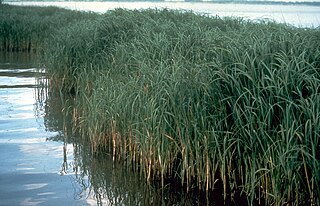
A halophyte is a salt-tolerant plant that grows in soil or waters of high salinity, coming into contact with saline water through its roots or by salt spray, such as in saline semi-deserts, mangrove swamps, marshes and sloughs, and seashores. The word derives from Ancient Greek ἅλας (halas) 'salt' and φυτόν (phyton) 'plant'. Halophytes have different anatomy, physiology and biochemistry than glycophytes. An example of a halophyte is the salt marsh grass Spartina alterniflora. Relatively few plant species are halophytes—perhaps only 2% of all plant species. Information about many of the earth's halophytes can be found in the ehaloph database.

Dianthus caryophyllus, commonly known as carnation or clove pink, is a species of Dianthus native to the Mediterranean region. Its exact natural range is uncertain due to extensive cultivation over the last 2,000 years. Carnations are prized for their vibrant colors, delicate fringed petals, and enchanting fragrance.
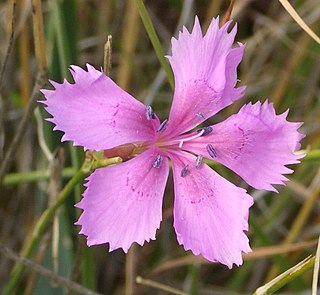
Dianthus is a genus of about 340 species of flowering plants in the family Caryophyllaceae, native mainly to Europe and Asia, with a few species in north Africa and in southern Africa, and one species in arctic North America. Common names include carnation, pink and sweet william.

A wildflower is a flower that grows in the wild, meaning it was not intentionally seeded or planted. The term implies that the plant is neither a hybrid nor a selected cultivar that is any different from the native plant, even if it is growing where it would not naturally be found. The term can refer to the whole plant, even when not in bloom, and not just the flower.
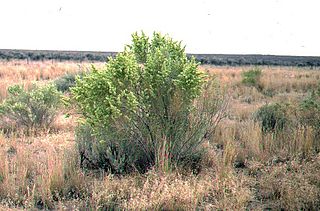
Saltbush is a vernacular plant name that most often refers to Atriplex, a genus of about 250 plants distributed worldwide from subtropical to subarctic regions. Atriplex species are native to Australia, North and South America, and Eurasia. Many Atriplex species are halophytes and are adapted to dry environments with salty soils.

Dianthus chinensis, commonly known as rainbow pink or China pink is a species of Dianthus native to northern China, Korea, Mongolia, and southeastern Russia. It is a herbaceous perennial plant growing to 30–50 cm tall.

Dianthus barbatus, the sweet William, is a species of flowering plant in the family Caryophyllaceae, native to southern Europe and parts of Asia. It has become a popular ornamental garden plant. It is a herbaceous biennial or short-lived perennial plant growing to 13–92 cm tall, with flowers in a dense cluster of up to 30 at the top of the stems. Each flower is 2–3 cm diameter with five petals displaying serrated edges. Wild plants produce red flowers with a white base, but colours in cultivars range from white, pink, red, and purple to variegated patterns. The exact origin of its English common name is unknown but first appears in 1596 in botanist John Gerard's garden catalogue. The flowers are edible and may have medicinal properties. Sweet William attracts bees, birds, and butterflies.

Dianthus deltoides, the maiden pink, is a species of Dianthus native to most of Europe and western Asia. It can also be found in many parts of North America, where it is an introduced species.

Dianthus armeria, the Deptford pink or grass pink, is a species of Dianthus ("pink") native to most of Europe, from Portugal north to southern Scotland and southern Finland, and east to Ukraine and the Caucasus. It is naturalised in North America.

Dianthus gratianopolitanus, commonly known as the Cheddar pink or clove pink, is a species of plant in the family Caryophyllaceae. It is a herbaceous perennial, hardy to zones 4–8. It grows to a height of 0.5 to 1 feet, blooming from May to June. Flowers are fragrant and rose pink. Grows best in full sun, and has medium water requirements. Overwatering or poor drainage leads to crown rot, and plants do not tolerate wet winter soil conditions.
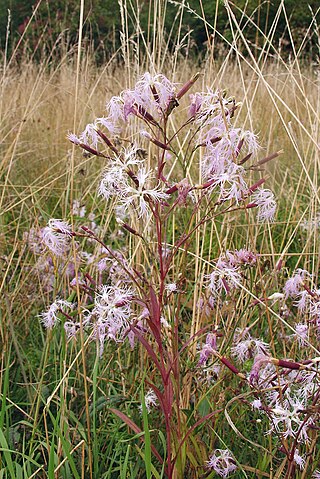
Dianthus superbus, the fringed pink or large pink, is a species of Dianthus native to Europe and northern Asia, from northernmost Spain and France north to arctic Norway, and east to Japan; in the south of its range, it occurs at high altitudes, up to 2,400 m.
Asparagus persicus, is a flowering plant in the Asparagaceae family. It grows between 800-1700 and is native to Turkey, Iran, Afghanistan, Uzbekistan, Tajikistan, Kazakhstan, China, Russia. It is perennial herbaceous halophyte plant up to 1.5 m tall. It is dioecious, with male and female flowers on separate plants.

Caryocolum schleichi is a moth of the family Gelechiidae. It is found in central, most of western and parts of eastern Europe, Morocco, Turkey, Syria, Afghanistan and Mongolia.
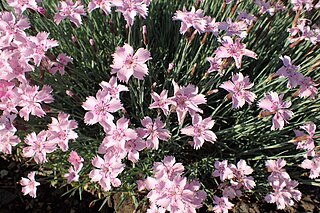
Dianthus plumarius, also known as the common pink, garden pink, wild pink or simply pink, is a species of flowering plant in the family Caryophyllaceae.

Dianthus crinitus is a species of Dianthus in the carnation family found in northwestern Africa, the eastern Aegean Islands, Anatolia, the Transcaucasus and the North Caucasus, Lebanon, Syria, Iran, the Gulf States, and Oman. Common names may be associated more with some subspecies than others, and include hairy carnation and long‑haired pink. It grows on serpentine soils.

Dianthus giganteus, the giant pink, is a species of pink native to Romania, the Balkan peninsula, and possibly nearby areas. A perennial with flowerheads reaching 1 m, it is useful in gardening and landscaping applications where a backdrop of taller plants is needed. It is available from commercial suppliers, with the Royal Horticultural Society considering it to be a good plant to attract pollinators.

Dianthus anatolicus is a herbaceous perennial plant belonging to the family Caryophyllaceae natively occurring from Turkey to Tibet.
Dianthus grossheimii, often called Grossheim's pink or Gvozdika Grossgejma, is native to Turkey and Transcaucasus. It is often found in mountain steppes and meadows.
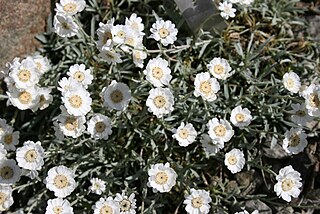
Achillea cretica, Cretan yarrow, is a species of flowering plant in the family Asteraceae, native to Greece, the East Aegean Islands, Crete, Turkey, and Cyprus. It is typically found in calcareous rocky areas such as cliffs, gorges, scree fields, and even ancient ruins, and is somewhat tolerant of salty conditions.
















